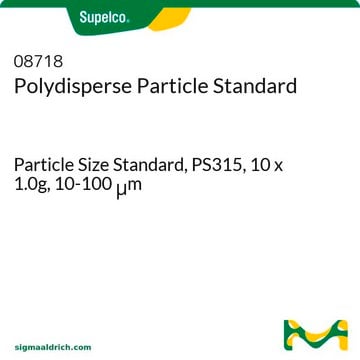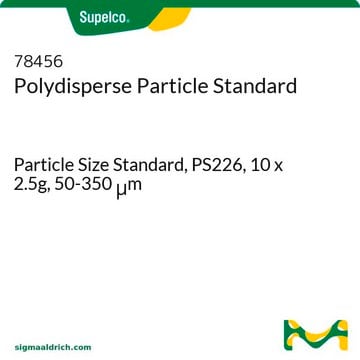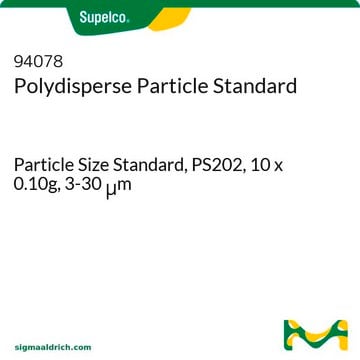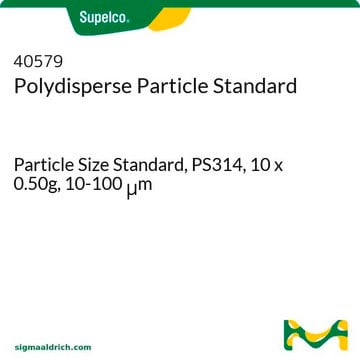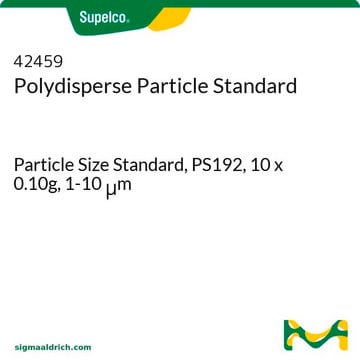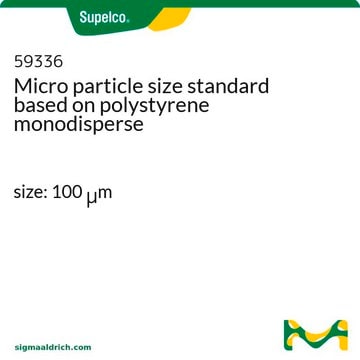57563
Polydisperse Particle Standard
Particle Size Standard, PS224, 10 x 0.50g, 50-350 μm
Sign Into View Organizational & Contract Pricing
All Photos(1)
About This Item
UNSPSC Code:
41116107
NACRES:
NA.24
Recommended Products
grade
analytical standard
form
particles
manufacturer/tradename
Whitehouse Scientific Ltd PS224
particle size
50-350 μm
application(s)
glass & ceramic
industrial qc
pharmaceutical
format
neat
Looking for similar products? Visit Product Comparison Guide
Related Categories
General description
Polydisperse Particle Standard (PS224, size: 50-350 μm) is a particle size standard, ideal to profile particle size distribution (PSD) of test samples.
This product is characterized by techniques such as electroformed sieve analysis and microscopy.
This product is characterized by techniques such as electroformed sieve analysis and microscopy.
Application
Used for particle size equipment calibration.
It can also be used to determine the precision and reproducibility of laser diffraction particle analyzer.
It can also be used to determine the precision and reproducibility of laser diffraction particle analyzer.
Features and Benefits
- suitable for routine instrument calibration checks, testing and corrections
- available as a neat sample
- traceable to NIST and SRM standards
Signal Word
Danger
Hazard Statements
Precautionary Statements
Hazard Classifications
Eye Dam. 1 - Skin Corr. 1B
Storage Class Code
8B - Non-combustible corrosive hazardous materials
WGK
WGK 1
Flash Point(F)
Not applicable
Flash Point(C)
Not applicable
Personal Protective Equipment
dust mask type N95 (US), Eyeshields, Gloves
Choose from one of the most recent versions:
Already Own This Product?
Find documentation for the products that you have recently purchased in the Document Library.
Guide to pharmaceutical product quality
Chemosphere, 53-83 (2018)
New insights on sources contributing dust to the loess record of the western edge of the Pampean Plain during the transition from the late MIS 2 to the early Holocene
Torre G, et al.
Chemosphere, 30(4), 537-545 (2020)
Revisiting the chronology and environmental conditions for the accretion of late Pleistocene-early Holocene Pampean loess (Argentina)
Torre G, et al.
Chemosphere, 213, 105-119 (2019)
Soil variables that determine lead accumulation in Bidens pilosa L. and Tagetes minuta L. growing in polluted soils.
Salazar M J, et al.
Geoderma, 279, 97-108 (2016)
The paleoclimatic message from the polymodal grain-size distribution of late Pleistocene-early Holocene Pampean loess (Argentina)
Torre G, et al.
Chemosphere, 42, 100563-100563 (2020)
Our team of scientists has experience in all areas of research including Life Science, Material Science, Chemical Synthesis, Chromatography, Analytical and many others.
Contact Technical Service